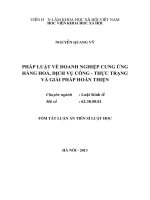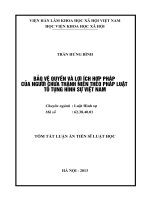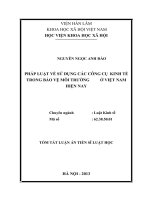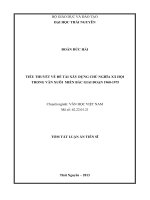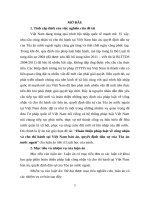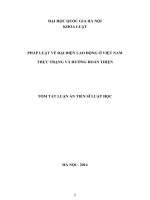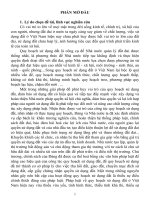1 luan an tien si bao ngu ve sinh truong 2010
Bạn đang xem bản rút gọn của tài liệu. Xem và tải ngay bản đầy đủ của tài liệu tại đây (5.47 MB, 240 trang )
Identification of Growth Related Quantitative
Trait Loci within the Abalone Haliotis midae
midae,
Using Comparative Microsatellite Bulked
Segregant Analysis
by
Ruhan Slabbert
Dissertation presented for the degree of Doctor of Philosophy (Agri
Agrisciences)
at Stellenbosch University
Supervisor: Dr. Rouvay Roodt-Wilding
Faculty of Agrisciences
Department of Genetics
December 2010
DECLARATION
By submitting this dissertation electronically, I declare that the entirety of the
work contained therein is my own, original work, that I am the authorship
owner thereof (unless to the extent explicitly otherwise stated) and that I have
not previously in its entirety or in part submitted it for obtaining any
qualification.
Signature:
Date: 23 November 2010
Copyright 2010 Stellenbosch University
All rights reserved
I
ABSTRACT
The South African abalone, Haliotis midae, is a commercially valuable mollusc and is
mostly exported to the Far East. Genetics research on H. midae has increased
substantially since a genetic improvement programme was introduced in 2006 by
collaboration between Stellenbosch University, government and industry partners. The
development of molecular markers, QTL-mapping, gene-expression and genome
manipulations are the main focuses of the research currently being conducted. The end
goal is to create high quality and fast growing animals for the industry. The present study
focused on the development of microsatellite markers and the detection of quantitative trait
loci (QTL) affecting growth traits (shell length, shell width, wet weight) in this species. A
combination of three methods, namely selective genotyping and bulked segregant analysis
(pooling analysis), single marker regression and interval mapping were used to identify
putative QTL in two full-sib families from two different farmed locations. Additional methods
and protocols were developed that can assist the industry in other molecular research
aspects. A total of 125 microsatellite loci were characterised. A total of 82 of these loci
were isolated using second generation sequencing, a first for any abalone species. A
preliminary, low-density framework linkage map was constructed containing 50 loci that
mapped to 18 linkage groups. The observed genome length was 148.72cM with coverage
of ±47%. QTL analyses revealed two putative QTL for shell width and wet weight, with
17% and 15% variance explained, that mapped on one linkage group in the first family and
three putative QTL, for shell length, shell width and wet weight, with 33%, 28.5% and
31.5% variance explained, that mapped on one linkage group in the second family.
Additional methods and protocols developed include an automated high-throughput DNA
isolation protocol, a real-time PCR assay for H. midae x H. spadicea hybrid verification, a
triploid verification microsatellite assay and a pre- and post-PCR multiplex setup and
optimisation protocol. Future studies focussing on QTL and marker assisted selection
(MAS) should verify the QTL found in this study and also utilise additional family structures
and determine QTL-marker phase within the commercial populations.
II
OPSOMMING
Die Suid-Afrikaanse perlemoen, Haliotis midae, is ’n kommersieel waardevolle
weekdier en word hoofsaaklik na die Verre-Ooste uitgevoer. Genetiese navorsing op H.
midae het aansienlik toegeneem sedert ’n genetiese verbeteringsprogram in 2006 deur
samewerking tussen die Universiteit van Stellenbosch, die regering en industrievennote
ingebring is. Die ontwikkeling van molekulêre merkers, KEL-kartering, geen-uitdrukking en
genoom manipulasies is die hooffokusse van die navorsing wat tans uitgevoer word. Die
einddoel is om hoë kwaliteit en snelgroeiende diere vir die industrie te skep. Die huidige
studie het op die ontwikkeling van mikrosatelliet merkers en die opsporing van
groeiverwante (skulplengte, -breedte en nat gewig) kwantitatiewe eienskap lokusse (KEL)
in hierdie spesie gefokus. ’n Kombinasie van drie metodes, naamlik selektiewe
genotipering en versamelde segregaat analise (samevoegingsanalise), enkel merker
regressie en intervalkartering is gebruik om waarskynlike KEL in twee vol-sibbe families
van twee verskillende produksiegebiede te identifiseer. Aanvullende metodes en protokolle
is ontwikkel wat die industrie in ander molekulêre navorsingsaspekte kan ondersteun. ’n
Totaal van 125 mikrosatelliet lokusse is beskryf. ’n Totaal van 82 van hierdie lokusse is
deur die gebruik van derde generasie volgordebepaling geïsoleer, ’n eerste vir enige
perlemoen spesie. ’n Voorlopige, laedigtheid raamwerkkoppelingskaart is saamgestel met
50 lokusse wat op 18 koppelingsgroepe gekarteer is. Die waarneembare genoomlengte
was 148.72cM met ’n dekking van ±47%. KEL-analises het twee waarskynlike KEL vir
skulpbreedte en nat gewig blootgelê wat 17% en 15% variasie verduidelik en is op een
koppelingsgroep in die eerste familie gekarteer asook drie waarskynlike KEL, vir
skulplengte, -breedte en nat gewig wat 33%, 28.5% en 31.5% variasie verduidelik en is op
een koppelingsgroep in die tweede familie gekarteer. Aanvullende metodes en protokolle
wat ontwikkel is, sluit ’n geoutomatiseerde hoë-deurgang DNS-isolasieprotokol, ’n intydse
PKR-proef vir H. midae x H. spadicea hibried verifikasie, ’n triploïed verifikasie
mikrosatellietproef en veelsoortige pre- en post-PKR opstelling en optimaliseringsprotokol
in. Toekomstige studies wat fokus op KEL en merker ondersteunde seleksie (MOS)
behoort die KEL wat in hierdie studie gevind is te verifieer en ook bykomende familie
strukture te benut om KEL-merker fases binne die kommersiële populasie te bepaal.
III
ACKNOWLEDGEMENTS
General Acknowledgements:
I would like to thank the following individuals for their technical assistance, guidance,
interesting discussions and moral support during the course of this study:
Abalone Hatcheries
Stephen Ashlin
Louise Jansen
Lise Schoonbee
Aquaculture / Molecular Aquatic Research Group
Rouvay Roodt-Wilding (supervisor)
Danie Brink
Aletta Bester-Van der Merwe
Dalene Badenhorst
Sonja Blaauw
Paolo Franchini
Nico Prins
Juli Hepple
Clint Rhode
Adelle Roux
Nicola Ruivo
Belinda Swart
Liana Swart
Nicol van den Berg
Alida Venter
Arnold Vlok
Peizheng Wang
Loraine Watson
IV
DNA Sequencing Facility / CENGEN
Dr. Rene Prins
Carel van Heerden
Institutional Acknowledgements:
I would like to thank the following institutions (alphabetically) and abalone hatcheries for
financial support and for providing tissue samples.
Abagold (Pty) Ltd.
Aquafarm (Pty) Ltd.
DNA Sequencing Facility
HIK Abalone Farm (Pty) Ltd.
Irvin and Johnson Abalone (I&J) Ltd.
Innovation Fund
Roman Bay Sea Farm (Pty) Ltd.
Stellenbosch University
V
TABLE OF CONTENTS
DECLARATION
I
ABSTRACT
II
OPSOMMING
III
ACKNOWLEDGEMENTS
IV
TABLE OF CONTENTS
VI
DECLARATION OF CONTRIBUTIONS
XV
LIST OF ABBREVIATIONS
XVII
LIST OF FIGURES
XXII
LIST OF TABLES
XXV
CHAPTER 1: INTRODUCTION
1
1.1) Overview of Taxonomy, Biology and Ecology
1
1.2) Overview of Global and Local Abalone Aquaculture
2
1.2.1) Global Aquaculture
2
1.2.2) Local Aquaculture
4
1.3) Overview of General and Molecular Research on Abalone Aquaculture
5
1.3.1) General Research on Abalone
5
1.3.2) Genetics Research on Aqua- and Mariculture Species
5
1.3.3) Genetics Research: Haliotis spp.
13
1.3.4) Genetics Research: Haliotis midae
14
1.4) Dissertation Layout
1.4.1) Aims
16
16
VI
1.4.2) Chapter 2
16
1.4.3) Chapter 3
17
1.4.4) Chapter 4
17
1.4.5) Chapter 5
17
1.4.6) Chapter 6
18
CHAPTER 2: MICROSATELLITE LOCI ISOLATION
19
SECTION 2.1: The Fast Isolation by AFLP of Sequences Containing
Repeats (Zane et al., 2002)
19
2.1.1) Introduction
19
2.1.2) Materials and Methods
20
2.1.2.1) Step 1: Samples and DNA Extractions
20
2.1.2.2) Step 2: Restriction and Ligation
20
2.1.2.3) Step 3: 1st AFLP Amplification
20
2.1.2.4) Step 4: Hybridisation
21
2.1.2.5) Step 5: Selective Capturing of Hybridised DNA
21
2.1.2.6) Step 6: 2nd AFLP Amplification
22
2.1.2.7) Step 7: Cloning
22
2.1.2.8) Step 8: Screening of Clones
23
2.1.2.9) Step 9: Sequencing of Clones
23
2.1.2.10) Step 10: Designing of Microsatellite Primers
23
2.1.2.11) Step 11: Amplification with Unlabelled Primers
24
2.1.2.12) Step 12: Poly-acrylamide Gel Electrophoresis (PAGE)
24
VII
2.1.2.13) Step 13: Labelling of Primers
25
2.1.2.14) Step 14: Characterisation of Labelled Primers
25
2.1.3) Results and Discussion
25
2.1.3.1) Step 3: 1st AFLP Amplification
25
2.1.3.2) Step 6: 2nd AFLP Amplification
26
2.1.3.3) Step 8: Screening of Clones
27
2.1.3.4) Step 11 and 12: Primer Optimisation and PAGE
27
2.1.3.5) Step 14: Characterisation of Labelled Primers
28
SECTION 2.2: Isolation and Characterisation of 63 Microsatellite Loci
for the Abalone, Haliotis midae
29
2.2.1) Introduction
29
2.2.2) Materials and Methods
29
2.2.2.1) DNA Extractions
29
2.2.2.2) Microsatellite Enrichment
30
2.2.2.3) Genotyping
30
2.2.2.4) Statistical Analyses
31
2.2.3) Results and Discussion
31
SECTION 2.3: Isolation and Segregation of 44 Microsatellite Loci in the
South African Abalone Haliotis midae L.
41
2.3.1) Introduction
41
2.3.2) Materials and Methods
41
2.3.3) Results and Discussion
43
VIII
SECTION 2.4: Microsatellite Marker Development in the Abalone
Haliotis
midae
Using
Pyrosequencing
(454):
Characterisation, In Silico Analyses and Linkage
Mapping.
50
2.4.1) Introduction
50
2.4.2) Materials and Methods
52
2.4.2.1) Sample Collection and DNA Extractions
52
2.4.2.2) Genomic Library Construction
52
2.4.2.3) Pyrosequencing and Primer Design
52
2.4.2.4) Genotyping
53
2.4.2.5) Statistical Analyses, Linkage Mapping and Bioinformatics
54
2.4.3) Results
55
2.4.3.1) Pyrosequencing and Primer Design
55
2.4.3.2) Statistical Analyses, Linkage Mapping and Bioinformatics
57
2.4.4) Discussion
73
CHAPTER 3: Genome Scan for QTL Affecting Size in Haliotis midae Using
Selective DNA Pooling and Microsatellite Loci
76
3.1) Introduction
76
3.2) Materials and Methods
78
3.2.1) Sampling and Phenotyping
78
3.2.2) DNA Extractions and Pool Construction
79
3.2.3) Parental and Pools Microsatellite Genotyping
80
3.2.4) Pooling Analysis
81
3.2.5) Individual Genotyping and Single Marker Regression
82
IX
3.2.6) Linkage Mapping and Interval Mapping
83
3.3) Results
84
3.3.1) Phenotyping
84
3.3.2) Pooling Analysis
84
3.3.3) Individual Genotyping and Single Marker Regression
86
3.3.4) Linkage Mapping
92
3.3.5) Interval Mapping
96
3.3.5.1) Family 42A
96
3.3.5.2) Family 7B
100
3.4) Discussion
102
CHAPTER 4: SUPPORTING METHODS AND STUDIES
105
SECTION 4.1: Non-Destructive Sampling of Juvenile Abalone using
Epipodial
Tentacles
and
Mucus:
Method
and
Application
105
4.1.1) Introduction
105
4.1.2) Material and Methods
106
4.1.2.1) DNA Extractions
106
4.1.3) Results and Discussion
107
SECTION 4.2: A Questionnare Based Evaluation of Economically
Important Traits in Haliotis midae
111
4.2.1) Introduction
111
4.2.2) Materials and Methods
112
4.2.2.1) Questionnaire
112
4.2.2.2) Data Analysis
112
X
4.2.3) Results
113
4.2.4) Discussion
114
SECTION 4.3: Multiplex Setup Protocol: Pre-PCR and Family Specific
Multiplexing
115
4.3.1) Introduction
115
4.3.2) Materials and Methods
116
4.3.2.1) Theoretical Multiplex Set-up
116
4.3.2.2) PCR Multiplexing Optimisation
117
4.3.2.3) Family-Specific Multiplexing
119
4.3.3.) Results and Discussion
120
4.3.3.1) PCR Multiplexing Optimisation
120
4.3.3.2) Family-Specific Multiplexing
122
CHAPTER 5: PROTOCOL DEVELOPMENT
126
SECTION 5.1: DNA Extraction Method Comparison for Haliotis midae
126
5.1.1) Introduction
126
5.1.2) Materials and Methods
126
5.1.2.1) Extraction Protocols
126
5.1.2.1.1) Protocol A: home-brewed CTAB buffer
127
5.1.2.1.2) Protocol B: home-brewed SDS buffer
127
5.1.2.1.3) Protocol C: kit based CTAB buffer
128
5.1.2.1.4) Protocol D: kit based SDS buffer
128
5.1.2.2) DNA Yield and Quality Evaluation
129
5.1.2.3) Tissue Collection and Sample Nomenclature
129
XI
5.1.3) Results
129
5.1.4) Discussion
131
SECTION 5.2: High-throughput DNA Extraction Protocol for
Haliotis midae
133
5.2.1) Introduction
133
5.2.2) Materials and Methods
133
5.2.2.1) Sample Preparation
5.2.3) Results and Discussion
133
134
SECTION 5.3: Depurination and Regeneration of 96-well Commercial
Silica DNA Extraction Plates
136
5.3.1) Introduction
136
5.3.2) Materials and Methods
136
5.3.2.1) First DNA Extraction (Pre-Regeneration)
136
5.3.2.2) Column Regeneration
137
5.3.2.3) Second DNA Extraction (Post-Regeneration)
138
5.3.2.4) Microsatellite and Real-time-PCR Analyses
138
5.3.3) Results
139
5.3.3.1) DNA Quantification
139
5.3.3.2) Real-time PCR and Microsatellite Genotyping
140
5.3.4) Discussion
141
SECTION 5.4: Hybrid Discrimination using High-Resolution Melt Curve
Analysis in Haliotis midae x Haliotis spadicea
142
5.4.1) Introduction
142
5.4.2) Materials and Methods
143
XII
5.4.2.1) Sample Preparation
143
5.4.2.2) Real-time PCR
143
5.4.3) Results and Discussion
143
SECTION 5.5: A Microsatellite Panel for Triploid Verification in the
Abalone, Haliotis midae
146
5.5.1) Introduction
146
5.5.2) Materials and Methods
147
5.5.2.1) Triploidy Induction and Sample Preparation
147
5.5.2.2) Initial Genotyping
147
5.5.2.3) Statistical Analysis
149
5.5.2.4) Multiplex Set-up and Experimental Triploidy Verification Protocol
150
5.5.3) Results
151
5.5.3.1) Initial Genotyping
151
5.5.3.2) Statistical Analysis
151
5.5.3.3) Triploidy Verification Protocol
151
5.5.4) Discussion
CHAPTER
6: CONCLUDING
153
REMARKS,
RECOMMENDATIONS
AND
FUTURE DIRECTIONS
157
6.1) Background
157
6.2) The Contributions of the Current Study to the Programme
158
6.3) Challenges and Recommendations (QTL-Mapping)
159
6.4) Future Directions in QTL Studies in Haliotis midae
160
REFERENCES
162
APPENDIX A: Microsatellite Loci Characterised by Myself (Ruhan Slabbert)
189
XIII
APPENDIX B: Multiplexes and Family Specific Multiplexes
192
APPENDIX C: Articles Published (Chronological)
195
XIV
DECLARATION OF CONTRIBUTIONS
Chapter 2, Section 2.2:
The following researchers contributed to this section: Nicola Ruivo and Nicol van den
Berg as part of their M.Sc. thesis and Darrell Lizamore as part of his B.Sc. (Hons) study.
Data analyses, interpretation and manuscript preparation was performed by myself
(Ruhan Slabbert). The markers designed by myself are shown in Appendix A, Table
A.1.
Chapter 2, Section 2.3:
The following researchers contributed to this section: Nicol van den Berg and Juli
Hepple as part of their M.Sc. thesis, Sonja Nel and Liana Swart as part of their B.Sc.
(Hons) study and Alida Venter as part of her position as technical laboratory assistant.
Analyses were performed by Juli Hepple. The data was interpreted and the manuscript
was written by myself (Ruhan Slabbert). The markers designed by myself are shown in
Appendix A, Table A.2.
Chapter 2, Section 2.4:
Juli Hepple provided technical assistance. Dr. Paolo Franchini created the local
databases and performed the bioinformatic analyses. All the markers reported in this
section were designed by myself (Ruhan Slabbert).
Chapter 3:
The general linear model was designed and the analyses performed by Mr. Justin
Harvey, Centre for Statistical Consultation, Stellenbosch University. MapQTL version 5
is the property of CenGen (Worcester, RSA) and I thank Dr. Rene Prins for allowing me
access to the software. The remaining analyses and practical work was performed by
myself (Ruhan Slabbert).
Chapter 4, Section 4.1:
The abalone survival data was collected by Mrs. Lise Schoonbee from Irvin and
Johnson Abalone. The rest of the work was performed by myself (Ruhan Slabbert).
Chapter 4, Section 4.2:
Adelle Roux assisted in the design and layout of the questionnaire. The data analysis
was performed by myself (Ruhan Slabbert).
XV
Chapter 4, Section 4.3:
The concept for setting up multiplexes specific for families was taken from the work of
Mr. Carel van Heerden. The practical work and multiplex design was performed by
myself (Ruhan Slabbert).
Chapter 5, Section 5.1:
The home-brew extractions were performed by Juli Hepple. All automated extractions
and data analysis were performed by myself (Ruhan Slabbert).
Chapter 5, Section 5.2:
The automated robotic platform was programmed by Mr. Carel van Heerden. The
extractions and data analysis was performed by myself (Ruhan Slabbert).
Chapter 5, Section 5.3:
The DNA Sequencing Facility covered the reagent and running costs for this
experiment. All practical work and data analysis were performed by myself (Ruhan
Slabbert).
Chapter 5, Section 5.4:
Adelle Roux provided the samples used in this section and also performed the
experimental hybrid crossings at HIK Abalone Farm. All other practical and data
analysis was performed by myself (Ruhan Slabbert).
Chapter 5, Section 5.5:
All practical and data analysis was performed by myself (Ruhan Slabbert).
XVI
LIST OF ABBREVIATIONS
3’
3-prime
5’
5-prime
[]
concentration
°C
degrees Celsius
>
greater than
<
less than
±
more or less
%
percentage
µg
microgram
µg/ml
micrograms per millilitre
l
microlitres
M
micromolar
A
adenine
AA
acrylamide
Acc. Nr.
GenBank accession number
AFLP
amplified fragment length polymorphism
ANOVA
analysis of variance
APS
ammonium persulfate
ATP
adenosine triphosphate
bp
basepairs
BLAST
basic local alignment search tool
Blastn
nucleotide-nucleotide BLAST
BSA
bovine serum albumin
XVII
cDNA
complimentary DNA
CH3COOH
acetic acid
CTAB
N-cetyl-N, N, N-trimethyl ammonium bromide
ddH2O
double distilled water
DNA
deoxyribonucleic acid
dNTP
deoxyribonucleotide triphosphate
DTT
di-thio-threitol
EDTA
ethylene diamine tetra-acetate
e.g.
for example
EST
expressed sequence tag
et al.
and company
F
forward
F1
filial generation one
FAM
carboxyfluorescein
FIASCO
Fast Isolation by AFLP of Sequences Containing Repeats
G
guanine
g
gram
GLM
general linear model
g/ml
grams per millilitre
Ho
observed heterozygosity
He
expected heterozygosity
HL
height of large allele
HS
height of small allele
HCl
hydrochloric acid
XVIII
Hm and Hmid
Haliotis midae (locus abbreviation)
HRMC
high resolution melt-curve analysis
H-W
Hardy-Weinberg
Kb
kilobases
KCl
potassium chloride
KEGG
Kyoto Encyclopedia of Genes and Genomes
kg
kilogram
LB
Luria Bertani medium
LOD
natural logarithm of the likelihood ratio
M
molar
MAS
marker assisted selection
Mb
megabases
mM
millimolar
mg
milligram
MgCl2
magnesium chloride
ml
millilitre
mm
millimetres
mg/ml
milligrams per millilitre
mM/L
millimolar per litre
mtDNA
mitochondrial deoxyribonucleic acid
n
number of individuals
na
number of alleles
N
indicate any one of A, T, C or G
N/A
not applicable
XIX
NaCl
sodium chloride
NaOH
sodium hydroxide
NCBI
National Center for Biotechnology Information
ND5
NADH dehydrogenase subunit 5
ng
nanogram
ng/µl
nanograms per microlitre
NS
non-significant
P
probability
PAA
poly-acrylamide
PAGE
poly-acrylamide gel electrophresis
PCR
polymerase chain reaction
pers. comm.
personal communication
pH
concentration of
hydrogen ions in a solution is expressed
conventionally as its pH
PIC
polymorphic information content
pmol
picomol
QTL
quantitative trait loci / locus
R
reverse
RAPD
random amplified polymorphic DNA
rcf
relative centrifugal force
RFLP
restriction fragment length polymorphism
rfu
relative fluorescent units
RSA
Republic of South Africa
SDS
sodium dodecyl sulfate
SNP
single nucleotide polymorphism
XX
SNX
StuI, NheI, XmnI
spp.
group of species
SSC
standard saline citrate
SSR
simple sequence repeat
STR
simple tandem repeat
T
thymine
Ta
annealing temperature
Taq
Thermus aquaticus DNA polymerase
TBE
Tris, boric acid, EDTA
TD-PCR
touch-down PCR
TE
Tris, EDTA
Temed
N, N, N’, N’-tetramethyl-ethylenediamine
TEN
Tris, EDTA, NaCl
Tris
2-amino-2-(hydroxymethyl)-1, 3-proanediol
U
unit
USD
United States Dollar (currency)
UV
ultra-violet
v/v
volume to volume
w/v
weight to volume
ZAR
South African Rand (currency)
XXI
LIST OF FIGURES
Figure 1.1: A simple diagramme representing an integrated recirculating system.
The blue arrows indicate the direction of the waterflow through the system.
3
Figure 2.1.1: Agarose gel showing the results of a 1st AFLP amplification (18 to
26 cycles). The red line indicates the 200bp band.
26
Figure 2.1.2: Agarose gel showing the results of a 2nd AFLP after the washing
steps. The red line indicates the 200bp band.
26
Figure 2.1.3: Agarose gel showing the results of a colony PCR. The red line
indicates the 250bp position.
27
Figure 2.1.4: Agarose gel results for HmLCS1T.
27
Figure 2.1.5: Poly-acrylamide gel electrophoresis results for HmLCS1T, showing
3 alleles.
28
Figure 2.4.1: Preliminary genetic linkage map of Haliotis midae. All microsatellite
loci marked with * indicate markers isolated in this study. Distances are given in
cM.
58
Figure 3.1: An abalone tagged with a bee-tag (green).
78
Figure 3.2: Sampling equipment used for collection of epipodial tentacles.
79
Figure 3.3: The measuring of shell length, indicated in red, and shell width,
indicated in blue.
79
Figure 3.4: An electropherogramme showing the parental alleles for Family 7B,
locus HmD59. The ratios for female (red line) and male alleles (blue line) are
calculated by dividing the height of the smaller allele (HS) by the height of the
larger allele (HL) and converting it to logratios.
82
Figure 3.5: Linkage groups comparison for the QTL sample map of Family 42A
between the map of Section 2.4 (2.4_LGx), the QTL samples in this chapter
(42A_LG1-3) and the map of Wang and Hepple (PZJH_42A_LGx).
93-94
XXII
Figure 3.6: Linkage groups comparison for the QTL sample map of Family 7B
between the map of Section 2.4 (2.4_LGx), the QTL samples in this chapter
(7B_LG1-2) and the map of Wang and Hepple (PZJH_7B_LGx).
95
Figure 3.7: Interval mapping results for Family 42A for shell length. Group 1 =
42A_LG1; Group 2 = 42A_LG2; Group 3 = 42A_LG3.
97
Figure 3.8: Interval mapping results for Family 42A for shell width. Group 1 =
42A_LG1; Group 2 = 42A_LG2; Group 3 = 42A_LG3.
98
Figure 3.9: Interval mapping results for Family 42A for wet weight. Group 1 =
42A_LG1; Group 2 = 42A_LG2; Group 3 = 42A_LG3.
99
Figure 3.10: Interval mapping results for Family 7B for shell length. Group 1 =
7B_LG1.
101
Figure 3.11: Interval mapping results for Family 7B for shell width. Group 1 =
7B_LG1.
101
Figure 3.12: Interval mapping results for Family 7B for wet weight. Group 1 =
7B_LG1.
101
Figure 4.1.1: An example of a mucus-containing filter paper.
107
Figure 4.1.2: Results of agarose gel electrophoresis (0.7%), showing the DNA
concentrations and quality of tentacles and mucus samples from the 12 juvenile
abalones studied.
108
Figure 4.1.3: Results of PCR reactions for tentacles and mucus samples from the
12 juvenile abalones studied, using HmD55 and HmD59.
109
Figure 4.2.1: Histogramme of ranked economically important traits. Red indicates
traits scoring below 50% and blue those scoring above 50%.
113
Figure 4.3.1: A Microsoft Excel sheet showing the initial multiplexing of markers.
LCS9 = NED, LCS47 and LCS48 = VIC, LCS63 and LCS67 = PET and LCS72 =
FAM.
117
Figure 4.3.2: Multiplex and control reactions results.
120
XXIII
Figure 4.3.3: Genotyping results for Multi#1. a) HmLCS9M; b) HmLCS47M; c)
HmLCS48M; d) HmLCS63T; e) HmLCS67M; f) HmLCS72M. 1) Multiplex at 57°C;
2) Multiplex at 60°C; 3) Control reaction.
121
Figure 4.3.4: Alleles of the NED labelled loci.
123
Figure 4.3.5: Alleles of the FAM labelled loci.
124
Figure 4.3.6: Alleles of the VIC labelled loci.
124
Figure 4.3.7: Alleles of the PET labelled loci.
125
Figure 5.1.1: A graphical representation of the yields for each buffer type.
130
Figure 5.1.2: A graphical representation of the 260/230 ratios for each buffer
type. The black line indicates the desirable 1.8 ratio.
130
Figure 5.1.3: A graphical representation of the 260/280 ratios for each buffer
type. The black line indicates the minimum ratio of 2.0.
131
Figure 5.2.1: The eight syringe Genesis RMP200 system.
134
Figure 5.3.1: A diagramme of a 96-well plate. The last two columns, 11 and 12,
were used for DNA extractions pre- and post-regeneration. The red wells indicate
those that contained tissue during the second (post-regeneration) DNA
extraction.
137
Figure 5.3.2: The melt-analysis of the post-regeneration PCR (in red = with tissue
and blue = without tissue) and a pre-regeneration sample (in green).
141
Figure 5.4.1: The normalised (top) and difference graph (bottom) of the highresolution melt analysis of the sperm lysin SNP for Haliotis midae (red), H.
spadicea (blue), the hybrid control (green) and the H.midae / H. spadicea hybrid
(black).
144
Figure 5.5.1: Electropherogrammes showing the alleles of each of the seven loci
used for triploid verification for a triploid (A) and a diploid (B) individual. Three
alleles can be observed for the triploid individual in some loci, while all loci of the
diploid individual have no more than two alleles.
152
XXIV
